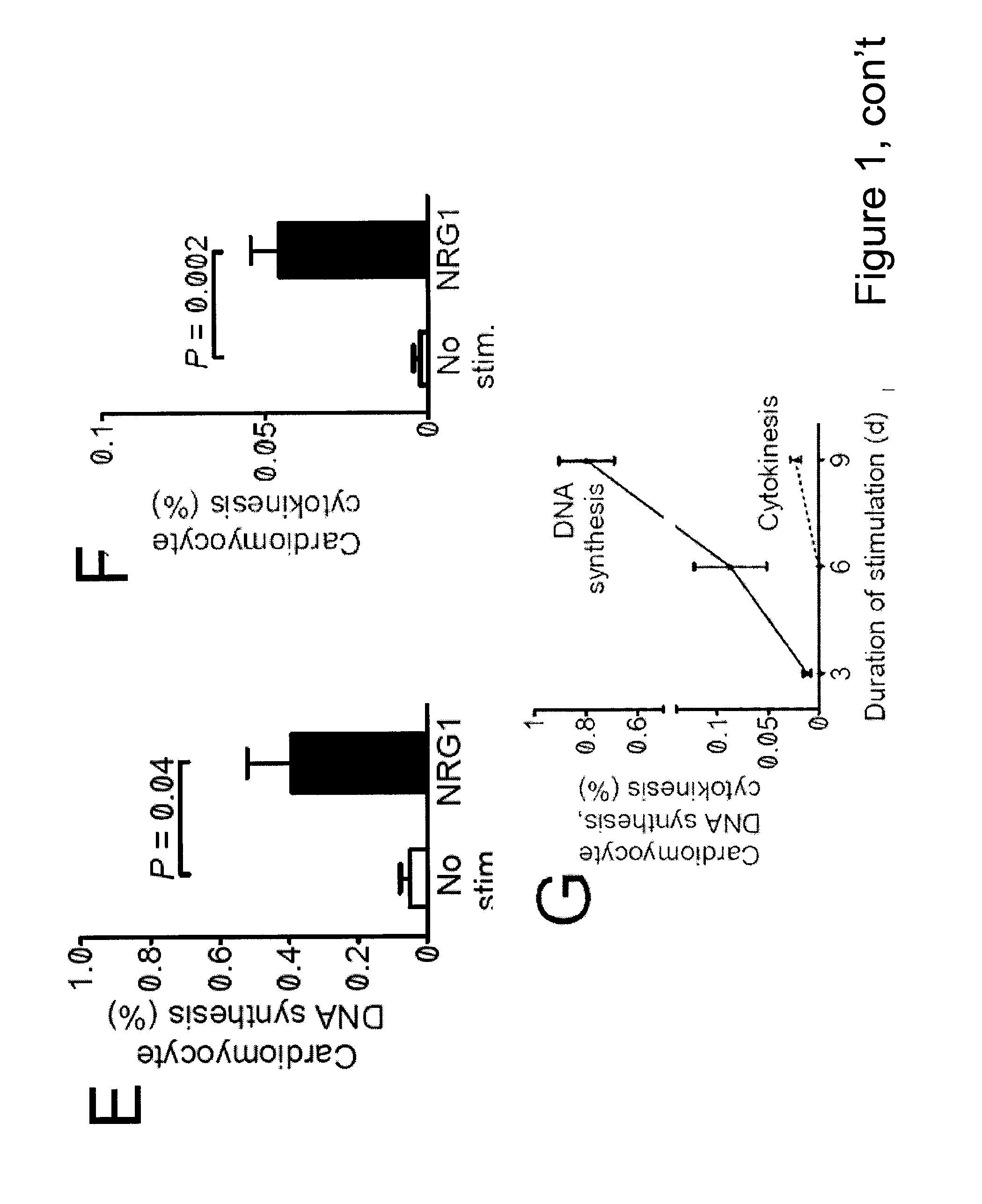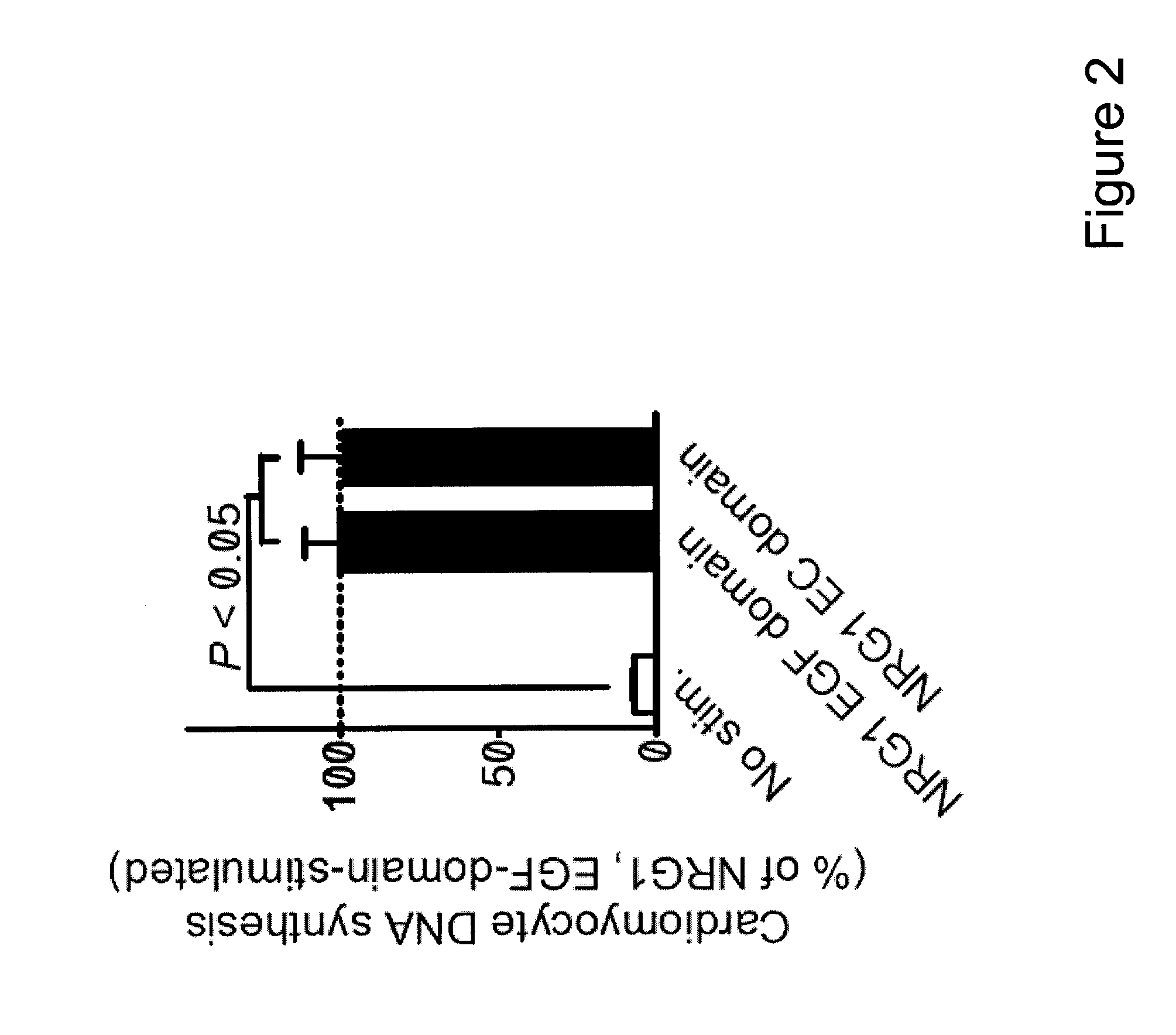Neuregulin induced proliferation of cardiomyocytes
a technology of cardiomyocytes and neutrophils, applied in the direction of skeletal/connective tissue cells, peptide/protein ingredients, drug compositions, etc., can solve the problems of inadequate human myocardial regeneration, affecting the survival rate of patients with myocardial infarction, so as to reduce slow down the onset of cardiac damage, and increase the cell cycle activity
- Summary
- Abstract
- Description
- Claims
- Application Information
AI Technical Summary
Benefits of technology
Problems solved by technology
Method used
Image
Examples
example 1
Materials and Methods
[0083]Experiments were approved by the Animal Care and Use Committee. Ventricular cardiomyocytes were isolated from male Wistar rats (12 week old, 300 g, Charles River Laboratories). We added NRG1 (EGF-like domain, amino acids 176-246 (SEQ ID NO:5); 100 ng / mL, R&D Systems), the peptide consisting of the four fasciclin 1 domains of human periostin (500 ng / mL; BioVendor) (SEQ ID NO:7), FGF1 (100 ng / mL; R&D Systems), HB-EGF (10 ng / mL; R&D Systems), or PDGF-BB (10 ng / mL; Peprotech). For detection of DNA synthesis, we added BrdU (30 μM) for the last three days. The c-ErbB2 / Neu blocking antibody was from Calbiochem.
Mouse Strains
[0084]ErbB4F / F mice were obtained from the NIH-sponsored Mutant Mouse Repository at University of California Davis and were originally produced by Dr. Kent Lloyd (Golub et al., 2004). The α-MHC-MerCreMer mice were obtained from the Jackson Laboratories and originally generated by Dr. Jeffrey Molkentin (Sohal et al., ...
example 2
NRG1 Stimulates Mononucleated Cardiomyocytes to Proliferate
[0094]To identify factors that promote myocardial regeneration, we screened extracellular factors for their ability to induce DNA synthesis in primary adult rat ventricular cardiomyocytes. Three extracellular factors induced cardiomyocyte cell cycle reentry. Two have been previously identified: fibroblast growth factor-1 and periostin. The novel factor was the epidermal growth factor-like domain of NRG1β (FIG. 1A, FIG. 2). NRG1 induced concentration-dependent DNA synthesis, which best fit a sigmoidal function, suggesting a receptor-mediated process (FIG. 1B). The half-maximal stimulation EC50 was at 40±3 pM (n=3, FIG. 1B), indicating a high-affinity interaction with the receptor. In cardiomyocytes, NRG1 binds to ErbB4, which leads to formation and activation of ErbB2 / ErbB4 hetero- or ErbB4 / ErbB4 homodimers. To determine whether ErbB2 is required for cardiomyocyte cell cycle reentry, we added a fixed concentration of NRG1 (12...
example 3
ErbB4 Controls Postnatal Cardiomyocyte Proliferation In Vivo
[0099]To determine whether the NRG1 / ErbB2 / ErbB4 complex controls cardiomyocyte proliferation in postnatal hearts in vivo, we disrupted the complex by genetically inactivating the ErbB4 gene. We treated α-MHC-MerCreMer+ / +; ErbB4F / F mice (test) and α-MHC-MerCreMer+ / +; ErbB4Wt / F (control littermates) with tamoxifen. Following ErbB4 inactivation on postnatal days 2-4, we analyzed the effect on postnatal day 19. Cardiomyocyte differentiation was not affected, as demonstrated by two observations: the formation of bi- and multinucleated cardiomyocytes was not altered (FIG. 4A), and cardiomyocytes from test and control mice had indistinguishable morphology (FIG. 4B). To determine whether ErbB4 is required for postnatal cardiomyocyte cell cycling, we quantified cardiomyocytes that incorporated BrdU (FIG. 4B). After 5 injections of BrdU on postnatal days 16-18, test mice had no detectable cardiomyocyte BrdU uptake, while control mice...
PUM
| Property | Measurement | Unit |
|---|---|---|
| step size | aaaaa | aaaaa |
| thickness | aaaaa | aaaaa |
| area | aaaaa | aaaaa |
Abstract
Description
Claims
Application Information
 Login to View More
Login to View More - R&D
- Intellectual Property
- Life Sciences
- Materials
- Tech Scout
- Unparalleled Data Quality
- Higher Quality Content
- 60% Fewer Hallucinations
Browse by: Latest US Patents, China's latest patents, Technical Efficacy Thesaurus, Application Domain, Technology Topic, Popular Technical Reports.
© 2025 PatSnap. All rights reserved.Legal|Privacy policy|Modern Slavery Act Transparency Statement|Sitemap|About US| Contact US: help@patsnap.com



